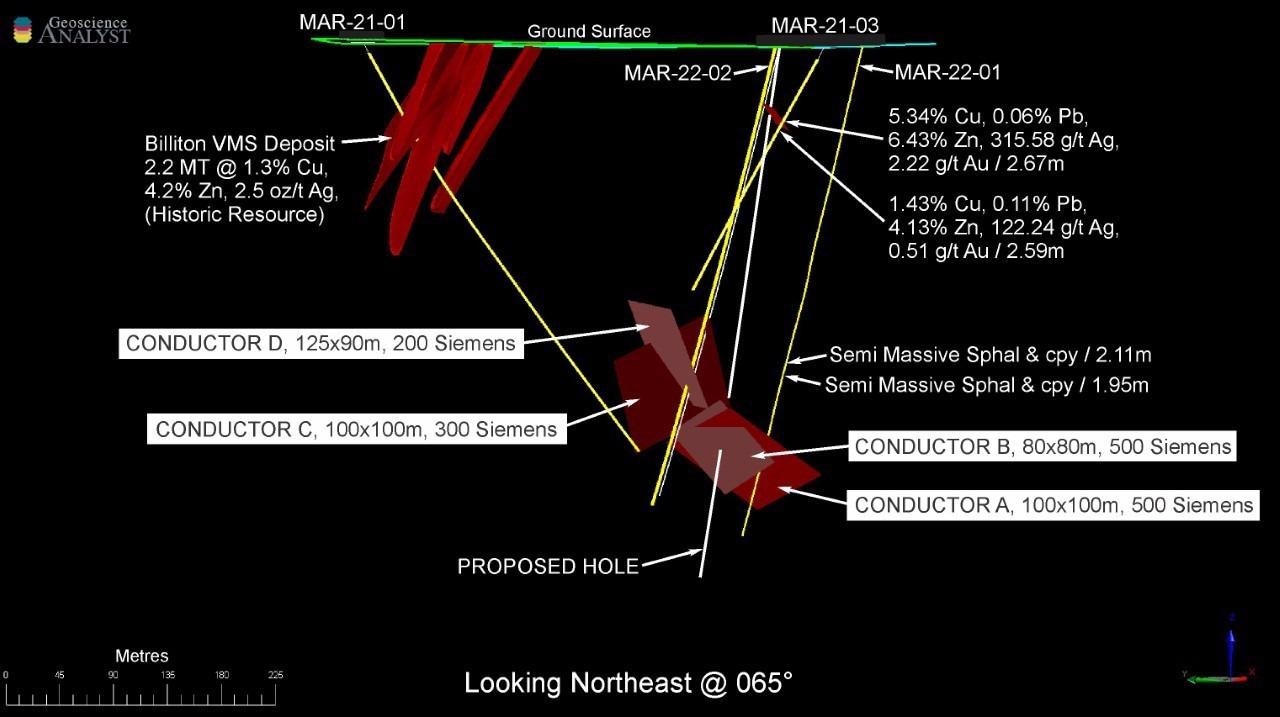Copper Lake Resources Ltd. is pleased to confirm that recent borehole electromagnetic (BHEM) investigations on its Marshall Lake copper-zinc-silver-gold volcanogenic massive sulfide (VMS) project, situated northeast of Thunder Bay, Ontario, have shown extremely positive findings.
 Location of deep conductors from borehole EM survey in relation to the 2021 – 2022 drill holes and the Billiton massive sulfide deposit. Image Credit: Copper Lake Resources Ltd.
Location of deep conductors from borehole EM survey in relation to the 2021 – 2022 drill holes and the Billiton massive sulfide deposit. Image Credit: Copper Lake Resources Ltd.
The BHEM surveys were carried out on three strategically placed drill holes to aid in the vectoring of thicker sulfide mineralization at the location of a new high-grade VMS find known as the VTEM/Deep IP discovery.
Borehole Electromagnetic Survey Results
Strong conductors were identified near the ends of all drill holes Mar-21-01, Mar-21-03, and Mar-22-02. Modeling indicates that all of the reactions are caused by a single, highly conductive source with a total area of at least 250 m × 150 m.
The study discovered four strong conductors at a depth of 250 m or more below the surface. Surveying was no longer possible at Hole Mar-22-01.
Conductors A and B, in particular, are well-defined, extremely powerful conductors located 325 m beneath the surface. Conductors C and D were likewise found to be strong conductors in holes Mar-21-01 and Mar-21-03.
The fact that all three drill holes acquired the same strong conductive response at depth shows that the conductor is larger than what the BHEM surveys predicted.
The existence of such strong conductors at depths greater than 300 m below ground level is highly promising, as it confirms the possibility for substantially bigger thicknesses of high-grade VMS mineralization to be discovered at deep.
Further diamond drilling is required to test these powerful conductors, with the priority hole testing the heart of the conductive source, which includes conductors A and B, as shown in the image above.
Summer Exploration Program Plans
Despite the abundance of strong conductors at depth, which is included within the wider conductivity and chargeability anomalies described by the deep IP/magnetotelluric survey, a ground large-loop pulse electromagnetic (PEM) study encompassing the whole big IP anomaly is being seriously considered.
Large loop electromagnetics will offer EM data to depths deeper than prior surveys (>300 m), allowing particular drill targets to be defined inside the larger IP anomaly.
The first objective for diamond drilling this summer will be to test the strong conductors beneath the new VTEM/Deep IP finding to further define this new zone of VMS mineralization.
An initial drill test of the Deeds Island VMS target will be the second priority. At this location, a large residual gravity anomaly (200 m × 100 m) is linked to a significant zinc geochemical anomaly, a zone of strong hydrothermal alteration, and many aerial EM conductors.
A 3D model of the gravity anomaly is now being created to aid in the identification of specific high-priority drill sites. The Deeds Island target, which is located 6 km east of the Billiton deposit, is a promising VMS prospect that has never been investigated by diamond drilling.